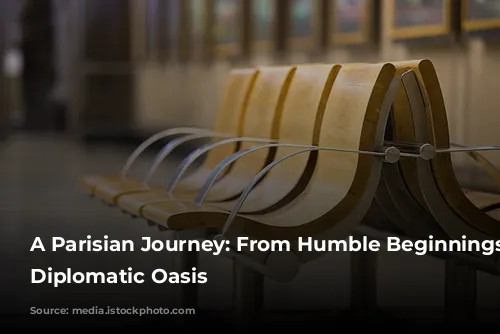The streets of Paris have witnessed centuries of change, with grand structures rising and falling, each leaving their mark on the city’s vibrant tapestry. One such story unfolds along the rue du Faubourg Saint-Honoré, a street steeped in history, where a humble dwelling transformed into the grand American Embassy.

A Humble Beginning: From Fields to Fashionable Homes
Imagine the year 1710. Paris was a city of contrasts, its old walls barely containing its bustling growth. Beyond the city limits, a peaceful countryside stretched towards the horizon, dotted with simple homes. This was the Faubourg Saint-Honoré, a tranquil retreat from the urban bustle. This is where Henri d’Aguesseau, the King’s Chancellor, chose to build his haven. He acquired a piece of land, the very spot where the American Ambassador’s Residence now stands tall.
D’Aguesseau, a man of taste and refinement, constructed a beautiful home, surrounded by a lush garden filled with vibrant flowers and bountiful vegetables. His home soon became a beacon for the elite, attracting other noble families who, in turn, erected their own opulent mansions. The area blossomed, becoming a prestigious neighborhood, its grand gardens extending towards the Champs-Elysées. Today, these historic gardens remain, offering a serene haven in the heart of Paris. Across the street, towering embassies stand guard, each a testament to its nation’s influence: the Japanese Embassy, the Cercle de l’Union Interalliée, the British Embassy, and the Elysée Palace, the French President’s residence.

A House of History: From Royalist Bastion to American Embassy
The story of the American Embassy is not simply one of grandeur, but of transformation, each owner leaving their mark on the building. After d’Aguesseau’s death, the property passed through the hands of several influential individuals. One notable figure was Charles Talleyrand, a renowned statesman, who acquired the house in 1778. This was followed by a period of royalist influence when the house was owned by the Comte Louis Le Pelletier de Mortefontaine, a prominent supporter of the monarchy.
The year 1836 brought a new chapter, as the property was purchased by a remarkable woman, the Baroness de Pontalba, a New Orleans native. She saw the potential of the site and commissioned a grand residence, tearing down the existing structure. This ambitious project was completed in 1842, resulting in the building we see today.
The Baroness’s legacy didn’t end there. After her passing, the house was acquired by Baron Edmond de Rothschild, a member of the renowned banking family. He lovingly restored the residence, ensuring it reached new heights of splendor. His son, Baron Maurice de Rothschild, inherited the house in 1934, but their plans for its future were abruptly disrupted by the outbreak of World War II.

The Shadows of War and a New Chapter Begins: From Occupation to Diplomatic Home
The war years cast a dark shadow over the house. Forced to flee to Switzerland, the Rothschilds left their home in the hands of the Nazi occupiers, who turned it into a club for Goering’s officers. While the Nazis made only minor changes, the Rothschilds suffered losses, with valuable items stolen during the war. Fortunately, with the help of James Mortimer and the Seventh Army, they managed to recover most of their possessions.
After the liberation of France, the residence was leased to the British Royal Air Force Club and then to the United States Government. Finally, in 1948, the United States purchased the building, laying the foundation for its transformation into a symbol of diplomatic cooperation.
A significant decision was made in 1966: the American Embassy would be moved from the Avenue d’Iena to the historic location on the rue du Faubourg Saint-Honoré. The move was a symbolic gesture, linking the United States to the city’s rich history. Renovation work, a testament to American craftsmanship, was completed in 1971. In January 1972, Ambassador Arthur K. Watson and his wife moved into their new home, marking the beginning of a new era.

A Living Link: The American Embassy as a Symbol of Friendship
Today, the American Embassy at 41, rue du Faubourg Saint-Honoré stands as a testament to the enduring bond between France and the United States. Each Ambassador has strived to preserve and enhance the Residence, ensuring it remains a symbol of friendship, welcoming those who seek to strengthen the ties between the two nations. The building’s story, woven into the fabric of Parisian history, serves as a reminder of the enduring power of diplomacy and the strength of international partnerships.










